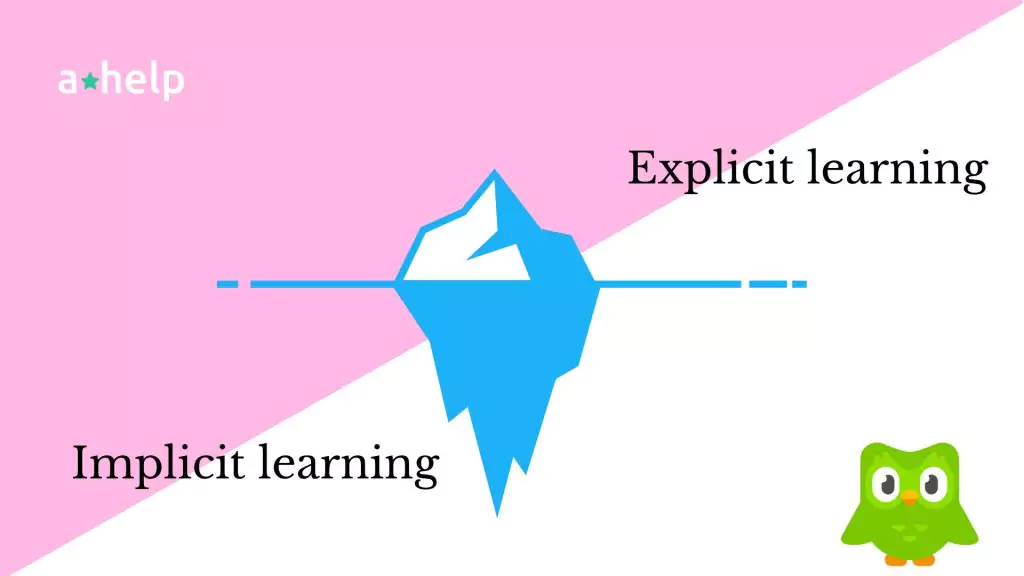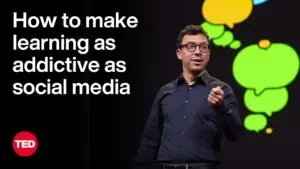Do you spend your evenings with Duolingo trying to master Spanish or Korean? Trust us, you are not alone. You must be one of 72.6 million users who practices foreign languages every month. While it is fun and engaging to learn something new with a friendly green owl, some language ethusiasts are doubting if they are acquiring all grammar. So, today we will find out if Duolingo is the real example of “implicit learning” or no?

✅ AI Essay Writer ✅ AI Detector ✅ Plagchecker ✅ Paraphraser
✅ Summarizer ✅ Citation Generator
Key Takeaways:
- Duolingo emphasizes learning by doing, but some users miss direct grammar explanations.
- Children absorb language patterns naturally, but it’s not always grammatically perfect. Adults benefit from some grammar guidance.
- While understanding grammar is important, it should be balanced with real-life language practice for true mastery.
What is implicit learning?
Implicit learning is like learning to ride a bike by doing it, rather than reading a manual. It’s about gaining knowledge through experience and practice without even realizing you’re learning. On the other hand, explicit learning is more about traditional methods where rules and concepts are directly taught.
“Implicit learning often happens without even realizing it.”
Both methods have their merits. The choice depends on what you aim to achieve with the information. But it’s essential to understand that knowing something doesn’t necessarily mean you can apply it effectively.

Implicit learning is like picking up things without realizing. In terms of languages, it means you start understanding the structure or grammar of a new language without even trying.
Rebuschat and Williams once did a study where they showed people sentences that looked like English but had a German grammar style. For example, ‘Since his parents groceries needed, purchased David everything necessary’. Even though the sentence sounds funny, people later got a feel for German grammar rules. The interesting part? These people didn’t even realize they were learning the rules!
This study proved that if you want to learn a new language, you need to feel the language first, and then understand it. The moment you become comfortable with new nuances and rules, you subconsciously start to understand a foreign language.
When picking up a new language, always listen and repeat. Use real-life situations. This way, you catch things that aren’t even in books or dictionaries. And sometimes, you won’t even realize you’re learning!
How Duolingo Utilizes Implicit Learning
Duolingo harnesses the power of implicit learning for its courses. The idea is simple: if you’re learning a language, it’s probably to use it in real conversations, not to boast about grammar rules.
From the first lesson, Duolingo has users engage directly with the language. This immersion method helps users detect patterns, formulate ideas, and actively use the language. Mistakes? They’re part of the deal. Making errors sharpens your focus and lets you understand patterns better.
“Mistakes are part of the learning process. They sharpen your focus.”
Duolingo’s approach capitalizes on the demand for less “boring” or “tedious” grammar-focused methods. This app introduces something fun and carefree. It’s like a game you play to learn any foreign language. Users online share their opinion why they prefer Duolingo to everything else:
“Language courses/books/CDs etc. that teach grammar have always existed, but people hate them because they are viewed as ‘boring’ or ‘tedious’.”
Indeed, for learners who’ve had previous exposure to a language, Duolingo seems like the ideal refresher. Many praise it as a tool to practice and make grammar rules second nature. Language enthusiasts believe that this app it a savior when it comes to different learning approaches:
“I think Duolingo is amazing for remembering a language you’ve dropped for a while.”
But in reality, learners come in different shapes and forms. While for some people interacting with language on the go sound alright, others may be confused by the fact that they are thrown in deep waters and left alone. Such type of students would opt for, what someone would call, a more conventional approach which comes in old but gold tips & guides, endless and boring rules, you name it.
That’s the reason why they met Duolingo’s idea to replace their “Tips and Notes” section by an AI chatbot with caution.
“When I used Duolingo, I frequently experienced that I did not understand why or how my answer was wrong. This happened all the time. The only way I knew that was to ask or by reading the relevant Tips and Notes. Now I’m expected to just “pick up” stuff? Sorry, not a fan anymore.”
Without clear explanations for errors, many find it challenging to grasp the nuances of the language. Duolingo is excellent for initiating someone into the world of language learning, it might not be sufficient for mastering a language from scratch. One user aptly summarized this by stating:
“At first, I didn’t have much confidence in my abilities to learn a new language, and duolingo was very unintimidating and gave me some basics I needed to feel confident in branching out to other resources.I‘m a fan of Duolingo introducing language learning to people who otherwise would never pursue it. I‘m not a fan of using Duolingo to learn a language.”
Still, many language learners reach the general consensus that Duolingo excels at making language learning accessible. Yet, for deeper language immersion and comprehensive understanding, many suggest branching out to other resources after an initial period with Duolingo.
Do Grammar Instructions Really Hinder Language Learning?
There’s a long-standing debate in the world of language learning. Some say that formal grammar instruction slows down the learning process. They believe it’s more natural and quicker to learn a language like children do, by simply listening and mimicking without diving into complex grammar rules. On the other hand, there are those who argue that understanding grammar is crucial for mastering a language. Let’s unpack this and see what’s really true.
First off, let’s think about how children learn languages. It’s true that they don’t sit with grammar books. Instead, they learn by listening and practicing. Over time, they make sense of the patterns. For example, a child might say:
“I goed to the park.”
They’ve picked up on the general rule in English that past tense often ends in “-ed.” However, they haven’t learned the irregular verb “go,” which becomes “went” in the past tense. This shows that implicit learning (learning by just picking things up) isn’t always perfect.
Now, consider an adult trying to learn a language without any grammar instruction. Imagine trying to learn German. The learner hears sentences:
“Das Mädchen liest ein Buch” (The girl reads a book) and “Die Jungen lesen Bücher” (The boys read books).
Without some understanding of grammar, the learner might be puzzled. Why “liest” in one case and “lesen” in another? It’s the grammar rule of verb conjugation based on the subject’s gender and number that explains this difference. Without some instruction, this might remain a mystery, making the language harder to grasp.
Yet, it’s also essential not to get bogged down in grammar. Someone who spends all their time understanding rules might struggle to have a simple conversation. It’s like learning all the rules of soccer but never playing a match. You know how it should be done, but you can’t actually do it.
So, what’s the balance? For most people, a mix of both methods works best. Grammar provides the framework, the bones of a language. It helps learners understand why sentences are constructed in a certain way. This can accelerate learning. On the other hand, real-life practice, listening, speaking, and immersing oneself in the language, puts flesh on those bones.
It’s a myth that grammar instructions always hinder language learning. They can actually be a useful tool. But, like any tool, they need to be used correctly. It’s the combination of understanding the rules and practicing them in real-life situations that leads to true language mastery. So, next time you’re puzzled by a tricky grammar rule, don’t fret! Remember it’s just one piece of the language puzzle, and with practice, it’ll make more and more sense.
Follow us on Reddit for more insights and updates.
Comments (2)
Welcome to A*Help comments!
We’re all about debate and discussion at A*Help.
We value the diverse opinions of users, so you may find points of view that you don’t agree with. And that’s cool. However, there are certain things we’re not OK with: attempts to manipulate our data in any way, for example, or the posting of discriminative, offensive, hateful, or disparaging material.





I fully agree. I have studied Swahili on Duolingo for a couple of years. While I can use it and say simpler phrases, the lack of structure leaves me bewildered. Without access to grammar, I don’t think it is possible to advance properly.
Thank you! I have spent 2+ years with Duolingo on French, Spanish and German but recently started with Latin and I’m pulling my hair out with frustration! This helped clarify that for me!!!